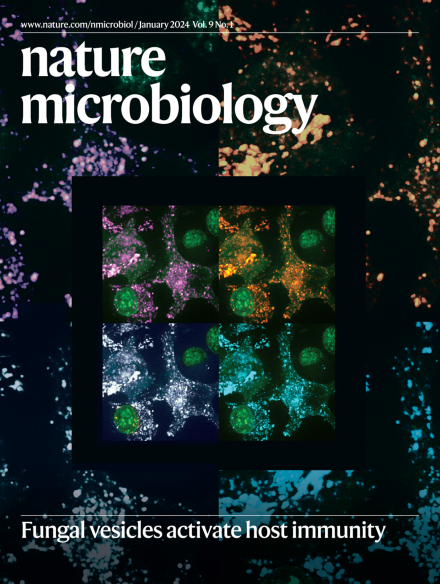人类肠道细菌产生结构相关的单糖脂与对比免疫功能。
IF 19.4
1区 生物学
Q1 MICROBIOLOGY
引用次数: 0
摘要
肠道共生体脆弱拟杆菌可产生α-半乳糖神经酰胺(BfaGCs)和鞘脂,具有调节结肠自然杀伤T细胞(NKT)的免疫调节功能。然而,它们的合成途径以及其他人类肠道细菌是否可以产生它们尚不清楚。本研究采用遗传和代谢组学方法,绘制了脆弱芽孢杆菌鞘脂生物合成途径,并确定α-半乳糖转移酶(agcT)在小鼠结肠NKT细胞调控中是必需的和充分的。agcT的分布仅限于拟杆菌科的少数种。然而,AgcT的结构同源物,如BgsB,广泛分布于肠道微生物群中,并产生α-糖基二酰基甘油(agdg),特别是在肠球菌中。对婴儿肠道宏基因组的分析显示,无论在哪个队列中,脆弱芽孢杆菌都占agcT丰度的主导地位,但编码bgsb的细菌在分类上是多样的,并随着宿主年龄的变化而动态变化。此外,在体外和体内,来自bagsb编码物种的agdg可作为bagc介导的NKT细胞活化的拮抗配体。我们的研究结果强调了免疫活性糖脂产生共生体的独特性质及其在人类肠道微生物组中的相关性,特别是在生命早期。本文章由计算机程序翻译,如有差异,请以英文原文为准。
Human gut bacteria produce structurally related monoglycolipids with contrasting immune functions.
Gut symbiont Bacteroides fragilis can produce α-galactosylceramides (BfaGCs), sphingolipids with immunomodulatory functions that regulate colonic natural killer T (NKT) cells. However, their synthesis pathway and whether other human gut bacteria can produce them are unclear. Here, using genetic and metabolomic approaches, we mapped the sphingolipid biosynthesis pathway of B. fragilis and determined that α-galactosyltransferase (agcT) is essential and sufficient for colonic NKT cell regulation in mice. The distribution of agcT is restricted to only a few species among Bacteroidales. However, structural homologues of AgcT, such as BgsB, are widely distributed in gut microbiota and produce α-glycosyldiacylglycerols (aGDGs), particularly in Enterococcus. Analysis of infant gut metagenomes revealed that B. fragilis predominantly accounts for agcT abundance regardless of the cohort, but bgsB-encoding bacteria were taxonomically diverse and showed dynamic changes with host age. In addition, aGDGs from bgsB-encoding species act as antagonistic ligands for BfaGC-mediated NKT cell activation in vitro and in vivo. Our findings highlight the distinct natures of immunoactive glycolipid-producing symbionts and their relevance in the human gut microbiome, particularly in early life.
求助全文
通过发布文献求助,成功后即可免费获取论文全文。
去求助
来源期刊

Nature Microbiology
Immunology and Microbiology-Microbiology
CiteScore
44.40
自引率
1.10%
发文量
226
期刊介绍:
Nature Microbiology aims to cover a comprehensive range of topics related to microorganisms. This includes:
Evolution: The journal is interested in exploring the evolutionary aspects of microorganisms. This may include research on their genetic diversity, adaptation, and speciation over time.
Physiology and cell biology: Nature Microbiology seeks to understand the functions and characteristics of microorganisms at the cellular and physiological levels. This may involve studying their metabolism, growth patterns, and cellular processes.
Interactions: The journal focuses on the interactions microorganisms have with each other, as well as their interactions with hosts or the environment. This encompasses investigations into microbial communities, symbiotic relationships, and microbial responses to different environments.
Societal significance: Nature Microbiology recognizes the societal impact of microorganisms and welcomes studies that explore their practical applications. This may include research on microbial diseases, biotechnology, or environmental remediation.
In summary, Nature Microbiology is interested in research related to the evolution, physiology and cell biology of microorganisms, their interactions, and their societal relevance.
 求助内容:
求助内容: 应助结果提醒方式:
应助结果提醒方式:


